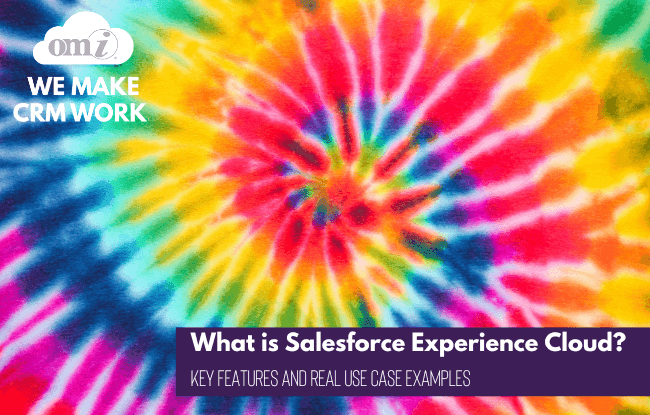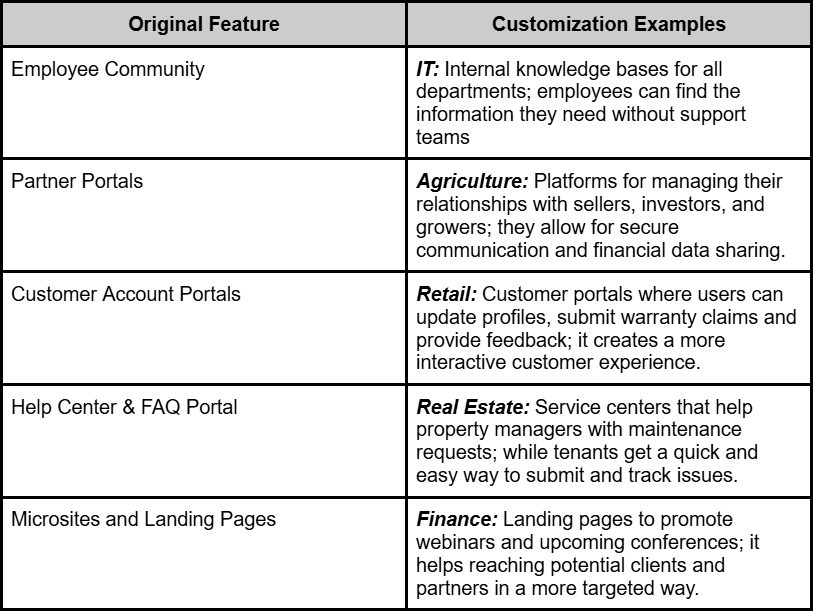What is Salesforce Experience Cloud? Key Features and Real Use Case Examples
Blog

According to the Builtwith.com report, Salesforce Experience Cloud is a go-to choice for building help centers, customer service portals, and partner communities of over 2,000 businesses. Glassdoor, Poshmark, Goodreads and many more – Experience Cloud boasts a number of high-profile clients that take full advantage of its portal technology. Since its release in 2014, it powers teams with over 10 million website visits per month and 50 million active community members.
But what does it actually do, and can it be useful for your business?
In this article, we’ll take a deep dive into what is Salesforce Experience Cloud, its key features, and how it can be applied in real-world scenarios. On top of that, we’ll see how Salesforce Experience Cloud differs from its predecessor, Community Cloud and how much it will cost you as of 2024.
What Is Salesforce Experience Cloud?
Salesforce Experience Cloud is a platform designed for businesses to securely connect their customers, employees, and partners for data exchange and communication. It’s built on Salesforce’s Customer 360 platform, allowing integration with other Salesforce products like Sales Cloud, Service Cloud, and Slack, as well as third-party systems.
The platform excels at creating environments where users can build stronger relationships with their customers and interact with external partners. So whether you’re running a support center or managing an eCommerce site, Experience Cloud offers you a digital space for your audience to engage, share documents, and collaborate in real time.
Salesforce Experience Cloud vs. Community Cloud
Experience Cloud vs Community Cloud is an interesting comparison, because the former is just a new and improved version of the latter. Salesforce originally introduced Community Cloud as a way for you to create online communities for collaboration. Over time, the product evolved into something far more robust, leading Salesforce to rebrand it as Experience Cloud in 2021.
The name change wasn’t just cosmetic – the new title also reflects a broader scope, moving from a focus on community building to one that enables an overall richer digital experience. Experience Cloud brings together all the capabilities of the old Community Cloud while adding features designed to improve customer service, increase engagement, and better manage partner relationships.
Key Salesforce Experience Cloud Features
Now let’s take a look what makes Experience Cloud well worth its money – we’ve handpicked ten key features of the platform that tend to make the biggest impact:
Digital Experience Management
One of the standout capabilities of Experience Cloud is its ability to adapt digital environments based on CRM data. Whether you’re creating custom workflows or integrating external information sources, this feature allows you to design specific user experiences based on their needs. With the right configuration, you can build portals that adapt to user behavior, making interactions more intuitive and relevant.
Knowledge Base
Experience Cloud provides a robust knowledge repository for both customers and internal users. You can publish articles and organize them into a knowledge base, making it easy to spread information across teams and to customers. For businesses with a significant customer support function, this is crucial in reducing the time needed to resolve issues, as users can search for answers themselves before reaching out for direct help.
High Level of Security
Security is a major focus for Salesforce, and Experience Cloud is no exception – the platform allows for granular control over who has access to what. Roles can be assigned, permissions set, and user interactions monitored.
Case Management
This functionality covers the entire lifecycle of a customer case, from when it’s first logged to when it’s resolved. With everything happening in one system, teams can better coordinate their efforts and deliver a faster response to customers and partners.
Lightning Flow Automation
Automating repetitive tasks is essential for improving operational efficiency. Experience Cloud allows you to create guided steps for users as they progress through different processes, whether it’s onboarding a new customer or completing a transaction. The automation also aids in employee recruitment, customer onboarding, and task management, reducing the manual work in these areas.
Roles and Advanced Sharing
The platform offers a detailed permission system where roles can be assigned to define what specific data users have access to. This is especially useful in environments that require strict data governance or in industries where collaboration across different stakeholders is needed, such as property management or finance.
Experience Builder
The Experience Builder tool is a game-changer for companies looking to customize their digital portals. Whether you’re starting from scratch or building on pre-built templates, Experience Builder offers a flexible way to adjust the portal’s design and layout to meet your branding and user experience needs.
Experience Workspaces
For admins and content creators, Experience Workspaces offer a centralized place to manage everything from content to user permissions. It simplifies moderation, content updates, and overall digital experience management. This feature is particularly helpful for teams that run multiple portals or microsites.
Salesforce Content Management System
Experience Cloud includes a built-in content management system (CMS) that allows you to store and manage their digital assets directly within the Salesforce ecosystem. This feature reduces the need for external CMS platforms and keeps your content management clean and simple.
Reports and Dashboards
Lastly, Experience Cloud offers built-in reporting and dashboard features that provide real-time insights into user activity. Your admins can easily track engagement levels, community health, and more.
Benefits of Using Salesforce Experience Cloud
- Centralized Knowledge Base: Salesforce Experience Cloud brings together all customer, partner, and internal data in one place, which reduces decision latency. Instead of wasting time searching across disconnected systems, users can instantly access critical data, make decisions, and act.
- Ultimate Operational Precision: With its granular control over user roles and permissions, you can assign specific access rights to different stakeholders. This is particularly valuable for teams that need to maintain strict access controls, like pharmaceutical companies managing confidential R&D projects.
- Adaptive Customer and Partner Experiences: Experience Cloud allows you to maintain flexibility by easily adapting portals and experiences for different user types without rebuilding entire systems from scratch.
- Sophisticated Automation: The system is capable of managing multi-step, cross-department workflows that previously required hands-on oversight, drastically reducing the possibility of human error.
- Consistent Brand Experience: With Experience Builder, you can fully align your digital portals with your branding, from visuals to the user experience. This doesn’t just maintain aesthetic consistency; it also strengthens customer trust and loyalty.
- Advanced Analytics: The platform’s analytics and reporting capabilities allow teams to go beyond surface-level metrics and understand the nuances of user behavior. This way, you can analyze which customer support articles lead to the fastest resolution times or which partner portals drive the most lead conversions.
- Customer-Driven Development: Because the platform allows you to interact directly with their customer base through communities and forums, companies can use this feedback loop to guide product or service development. For example, tech firms can use customer input from Experience Cloud to identify bugs or suggest new features.
What You Can Build with Salesforce Experience Cloud: Real Examples
The flexibility of Salesforce Experience Cloud means it can be used to create a variety of digital environments. Below are some Salesforce Experience Cloud examples of customizations you can build using the platform, depending on your industry:

Salesforce Experience Cloud Licenses Pricing Comparison
When it comes to Salesforce Experience Cloud pricing, you have several licensing options depending on your use case. These include Customer Communities, Partner Relationship Management, and External Apps, each priced based on the number of logins or members per month.
- Customer Communities: This plan is split into two versions – Customer Community and Customer Community Plus. Customer Community costs $2 per login or $5 per member, while Customer Community Plus starts at $6 per login or $15 per member. The Plus version offers more advanced features, such as roles and permission sets.
- Partner Relationship Management: Priced at $10 per login or $25 per member, this plan includes features like automated lead distribution and custom workflows designed for managing partner relationships.
- External Apps: At $15 per login or $35 per member, this plan allows for the creation of custom portals and applications, offering advanced access management and the ability to store up to 100 custom objects.
Conclusion
In the end, Salesforce Experience Cloud is a highly flexible platform that can be made into a customer service portal or a partner management solution, among other things. And its ability to integrate with other Salesforce products, coupled with strong security features and advanced automation tools, makes it a very attractive option for teams looking to improve how they interact with external stakeholders.
At the same time, a successful implementation of Salesforce Experience Cloud is far from easy. While you can perform it yourself, you may benefit way more from collaborating with a certified Salesforce customization expert like OMI. We boast almost three decades of experience under our belt – and we will make all the theoretical Salesforce features and benefits become reality.